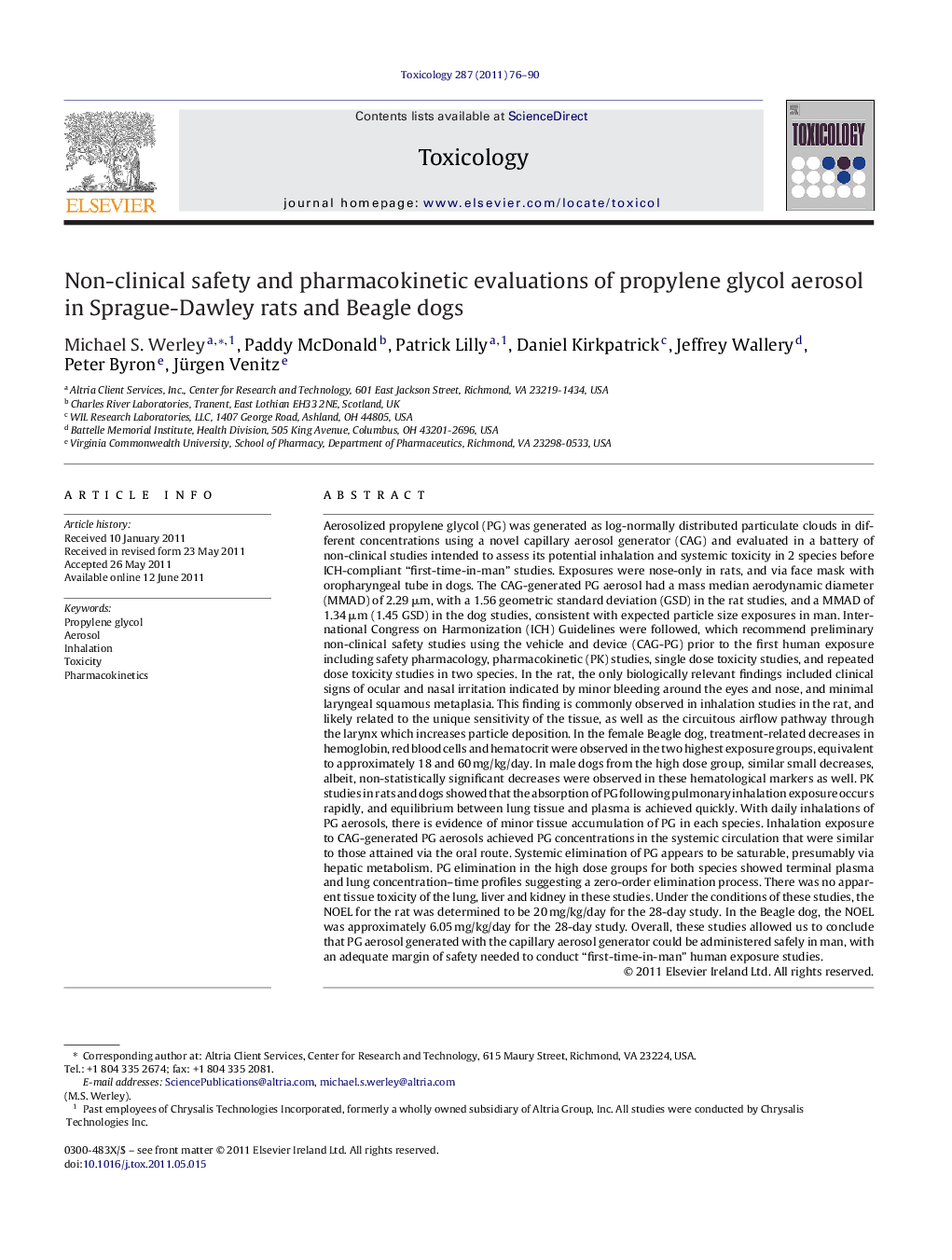| کد مقاله | کد نشریه | سال انتشار | مقاله انگلیسی | نسخه تمام متن |
|---|---|---|---|---|
| 2596020 | 1562370 | 2011 | 15 صفحه PDF | دانلود رایگان |

Aerosolized propylene glycol (PG) was generated as log-normally distributed particulate clouds in different concentrations using a novel capillary aerosol generator (CAG) and evaluated in a battery of non-clinical studies intended to assess its potential inhalation and systemic toxicity in 2 species before ICH-compliant “first-time-in-man” studies. Exposures were nose-only in rats, and via face mask with oropharyngeal tube in dogs. The CAG-generated PG aerosol had a mass median aerodynamic diameter (MMAD) of 2.29 μm, with a 1.56 geometric standard deviation (GSD) in the rat studies, and a MMAD of 1.34 μm (1.45 GSD) in the dog studies, consistent with expected particle size exposures in man. International Congress on Harmonization (ICH) Guidelines were followed, which recommend preliminary non-clinical safety studies using the vehicle and device (CAG-PG) prior to the first human exposure including safety pharmacology, pharmacokinetic (PK) studies, single dose toxicity studies, and repeated dose toxicity studies in two species. In the rat, the only biologically relevant findings included clinical signs of ocular and nasal irritation indicated by minor bleeding around the eyes and nose, and minimal laryngeal squamous metaplasia. This finding is commonly observed in inhalation studies in the rat, and likely related to the unique sensitivity of the tissue, as well as the circuitous airflow pathway through the larynx which increases particle deposition. In the female Beagle dog, treatment-related decreases in hemoglobin, red blood cells and hematocrit were observed in the two highest exposure groups, equivalent to approximately 18 and 60 mg/kg/day. In male dogs from the high dose group, similar small decreases, albeit, non-statistically significant decreases were observed in these hematological markers as well. PK studies in rats and dogs showed that the absorption of PG following pulmonary inhalation exposure occurs rapidly, and equilibrium between lung tissue and plasma is achieved quickly. With daily inhalations of PG aerosols, there is evidence of minor tissue accumulation of PG in each species. Inhalation exposure to CAG-generated PG aerosols achieved PG concentrations in the systemic circulation that were similar to those attained via the oral route. Systemic elimination of PG appears to be saturable, presumably via hepatic metabolism. PG elimination in the high dose groups for both species showed terminal plasma and lung concentration–time profiles suggesting a zero-order elimination process. There was no apparent tissue toxicity of the lung, liver and kidney in these studies. Under the conditions of these studies, the NOEL for the rat was determined to be 20 mg/kg/day for the 28-day study. In the Beagle dog, the NOEL was approximately 6.05 mg/kg/day for the 28-day study. Overall, these studies allowed us to conclude that PG aerosol generated with the capillary aerosol generator could be administered safely in man, with an adequate margin of safety needed to conduct “first-time-in-man” human exposure studies.
► CAG-PG generated over the course of the studies was fully inhalable in rats and dogs.
► Findings included ocular, nasal irritation, and laryngeal squamous metaplasia in the rat.
► Effects upon the erythron in females from the mid-2 and high doses were observed.
► Systemic elimination of PG appears to be saturable, likely via hepatic metabolism.
Journal: Toxicology - Volume 287, Issues 1–3, 5 September 2011, Pages 76–90